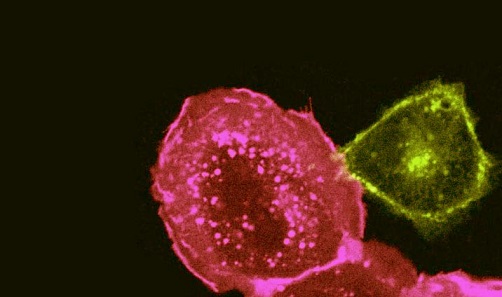Russian study uncovers cholesterol's critical role in SARS-CoV-2 E protein function
Nikhil Prasad Fact checked by:Thailand Medical News Team Aug 27, 2024 1 year, 4 months, 5 days, 12 hours, 6 minutes ago
Medical News: Researchers from the A.N. Frumkin Institute of Physical Chemistry and Electrochemistry at the Russian Academy of Sciences and N.I. Pirogov Russian National Research Medical University have recently unveiled groundbreaking insights into the behavior of the SARS-CoV-2 E protein, a vital component of the virus that has caused the global COVID-19 pandemic. This
Medical News report explores the study's key findings, revealing how the E protein's interaction with cell membranes is heavily influenced by cholesterol levels, a discovery that could have significant implications for understanding the virus's life cycle and developing therapeutic strategies.
 Russian study uncovers cholesterol's critical role in SARS-CoV-2 E protein function
The Enigmatic E Protein and Its Function
Russian study uncovers cholesterol's critical role in SARS-CoV-2 E protein function
The Enigmatic E Protein and Its Function
The SARS-CoV-2 virus, responsible for COVID-19, comprises several structural proteins, among which the envelope (E) protein stands out for its critical roles, yet remains one of the least understood components. The E protein is involved in the assembly and budding of new virions, making it essential for the virus's ability to replicate and spread. Additionally, this small, 75-amino-acid protein is believed to function as a viroporin, forming ion channels that disrupt the host cell's ion balance, leading to cellular stress and contributing to the severe respiratory symptoms associated with COVID-19.
Despite its importance, the exact mechanisms by which the E protein operates within the host cell membrane have been unclear. Previous studies have suggested that the E protein could oligomerize, forming structures ranging from dimers to pentamers. However, the specific conditions under which these structures form and their functional implications were not fully understood. The new study sheds light on these mechanisms, particularly highlighting the role of cholesterol in regulating the E protein's behavior.
Cholesterol's Impact on E Protein Function
The research team conducted a series of experiments using techniques such as patch-clamp, confocal fluorescence microscopy, and atomic force microscopy to examine how the E protein interacts with membranes under different conditions. They found that cholesterol plays a pivotal role in determining the E protein's activity and its ability to form membrane pores.
When the E protein was introduced to membranes with low or no cholesterol content, it exhibited minimal activity, forming only short-lived, transient pores. These small defects in the membrane, as observed through atomic force microscopy, were semi-transmembrane, meaning they only penetrated partway through the membrane. This mode of activity likely corresponds to dimeric forms of the E protein that are unable to fully oligomerize into more stable structures.
However, as the cholesterol content in the membrane increased to around 30%, a significant change occurred. The E protein began to form more stable, long-lived channels that fully penetrated the membrane. These channels were observed to be
stable for several minutes, suggesting the formation of pentameric or larger oligomeric structures. The study demonstrated that at 40% cholesterol content, typical of the plasma membrane, these channels became highly stable, indicating that the E protein's viroporin activity is strongly dependent on the lipid environment, particularly cholesterol levels.
Expanding on Key Study Findings
The research team conducted a detailed analysis of the E protein's behavior under varying cholesterol conditions. In membranes with 0% and 15% cholesterol, the E protein formed only semi-transmembrane pores with a depth of about 2 nanometers. These pores were short-lived and likely did not contribute significantly to viral replication. However, when the cholesterol content was increased to 30%, the depth of the pores doubled, indicating that the E protein was forming more substantial, transmembrane channels.
Interestingly, the study also revealed that the E protein did not exhibit significant membrane activity in the absence of negatively charged lipids. This suggests that the protein's ability to interact with the membrane is not only dependent on cholesterol but also on the presence of specific lipid types. This dual dependency highlights the complexity of the E protein's function and suggests that the virus may be finely tuned to exploit specific host cell environments.
The findings were further supported by patch-clamp experiments, which showed that the E protein induced different types of membrane conductance depending on the lipid composition. In cholesterol-rich environments, the protein formed stable, square-top signals indicative of long-lived ion channels, whereas in cholesterol-poor environments, only brief, spike-like conductance events were observed.
Implications and Therapeutic Development
The findings of this study have important implications for understanding how SARS-CoV-2 operates within the human body. The dependence of the E protein's activity on cholesterol suggests that the virus may exploit specific lipid environments within host cells to enhance its replication and spread. For example, the high cholesterol content in the plasma membrane could facilitate the formation of stable E protein channels, promoting viral egress and infection of new cells.
Moreover, these insights could inform the development of new therapeutic strategies. Targeting the interaction between the E protein and cholesterol, or modulating cholesterol levels within specific cellular compartments, might offer a novel approach to disrupting the virus's life cycle. This could be particularly relevant for antiviral drug development, where inhibiting the formation of stable E protein channels could reduce the virus's ability to cause disease.
Conclusion
This study offers a detailed look into the SARS-CoV-2 E protein's interactions with cell membranes, emphasizing the crucial role of cholesterol in regulating its activity. By forming stable, cholesterol-dependent channels, the E protein may play a key role in the virus's ability to replicate and cause disease. These insights not only enhance our understanding of COVID-19 pathogenesis but also open up new avenues for therapeutic intervention.
The study findings were published in the peer-reviewed journal: Biomolecules.
https://www.mdpi.com/2218-273X/14/9/1061
For the latest COVID-19 News, keep on logging to Thailand
Medical News.
Read Also:
https://www.thailandmedical.news/news/covid-19-news-cholesterol-and-ceramides-facilitate-sars-cov-2-spike-protein-mediated-membrane-fusion-which-can-be-inhibited-by-chlorpromazine
https://www.thailandmedical.news/news/sars-cov-2-news-phosphatidylinositol-phosphate,-cholesterol-and-genes-tmem106b,-vac14,-scap-used-by-sars-cov-2-to-infect-human-cells
